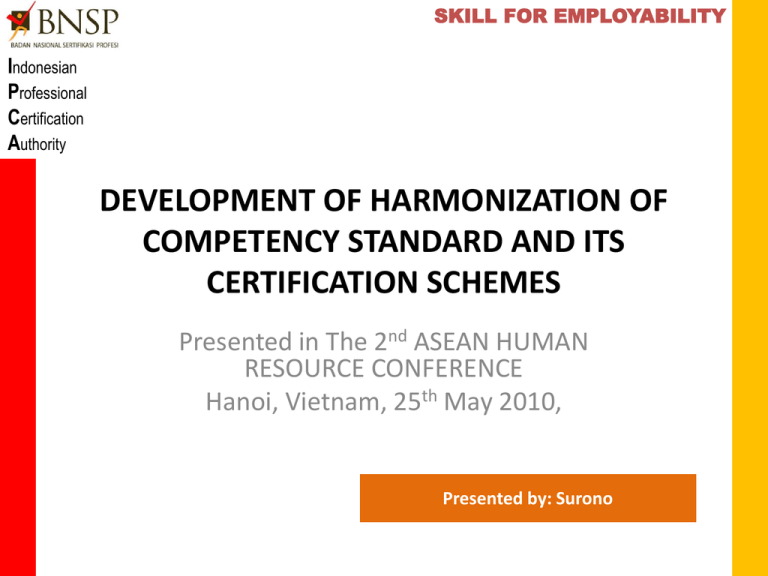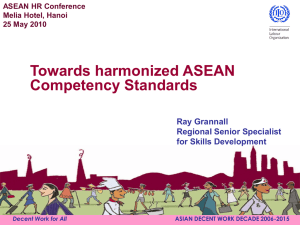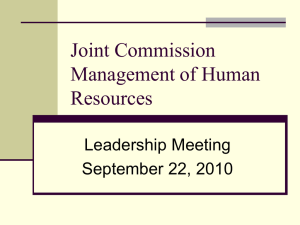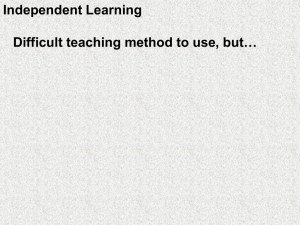development of HARMONIZATION OF CompetencY
advertisement

SKILL FOR EMPLOYABILITY Indonesian Professional Certification Authority DEVELOPMENT OF HARMONIZATION OF COMPETENCY STANDARD AND ITS CERTIFICATION SCHEMES Presented in The 2nd ASEAN HUMAN RESOURCE CONFERENCE Hanoi, Vietnam, 25th May 2010, Presented by: Surono BACKGROUND • The HRD activities have been playing a significant role on the economic recovery and growth in Indonesia which also strongly contributes to regional development. • The concrete activities of HRD are to develop Competency Based Recruitment, Training, and Maintaining of competency to improve quality and productivity and ensure the business partner that the product are produced by competent personel consistently. • Standardization contributes to the basic infrastructure that underpins society including health and environment while promoting sustainability and good regulatory practices. THE REQUIREMENT OF INDUSTRY SYSTEM ON COMPETENCY PERSONNEL. • Most Industry based system such as ISO 9000 series, ISO 17025, ISO 17024, ISO 17021, ISO 22000, ISO 14000 etc require competence of personnel. Industries implementing the system shall have a management commitment to ensure the use and maintaining the competence of their personnel. In the case of failure in production of services/product caused by personnel, the industry should do retraining and reassess the competence of the personnel. • Communication of competence development and recognition system and industry based system is not optimum yet. So that some industries have not recognize the system. However, with the effort of the government, industry association, professional association, training provider, and Certification bodies in socialisation of the system, some industries move to implement and recognize the system. THE NEED OF COMPETENCY STANDARDS FOR HRD IN RECRUITMENT, TRAINING AND MAINTAINING PERSONNEL COMPETENCIES TO INCREASE PRODUCTIVITY AND COMPETITIVENESS. • • • The limited availability of competency standard brings dificulty for industries to identify the actual competency needed to inform to the job seeker, Labor Market Information, and training organization. This situation lead forces industry requirements in their recruitment program are limited on formal general education degree, experience in the area and method for selection by psychometric testing. The lack of competency standard also bring difficulty for industry in developing modul and curriculum, and to ensure the achievement of the competency effectively and efficiently. The lack of competency standard also brings difficulty to industry in doing reassessment of the result of retraining by industry for maintaning the employee competencies, career and remuneration development to improve quality, productivity and competitiveness. THE NEED OF OCCUPATIONAL STANDARDS FOR TVET TO ENSURE LINK AND MATCH WITH INDUSTRY NEEDS OF THE COMPETENCY . • • • Based on the RMCS mapping of business functions, the Unit of competency indicate basic function in industry system. This consistent format will enhanced Training Need Analysis in developing training program, modul and curriculum in TVET and ensure the link and match between competency industry needs and the CBT program. The format of competency standard based on RMCS show the title of standard as basic function written in performative sentences, the elements indicate the step of the processing activities, and performance criteria indicate the work instruction in every step of production process. These components of RMCS standard found are in line with the structure of curriculum which sequently states Topic of the module, learning outcome, and criteria for evaluation. Therefore with this equivalency of the format and components will lead to the TVET program can ensure the link and macth between industry needs and training program. Since competency standard developed based on industry system which have been agreed in international convention, most of competency standards are generally equivalent in some countries, therefore it should not be to difficult to harmonize them. Therefore it would be great if countries in the ASEAN region could have integrated program in developing standard, since the development of standard of competency needs a lot of resources (time and money). The correlation between competency Standard and Curriculum CBT- Curriculum 1) Learning Topic / Modul / Competency Standard (RMCS) 1) Unit Competence 2) Learning Outcome 2) Elements 3) Assessment Methods 3) Performance Crateria 4 a) Training Methodology 4) Range of variable b) Learning materials c) Reference THE NEED HARMONIZATION FOR RECOGNITION FOR HRD COMPETENCY BASED BETWEEN INDUSTRIES, ORGANIZATION, AND BUSINESS PARTNER COUNTRIES. • The differences of competency certification and training scheme in a country moreover in a region are frequent causes to the problem for achieving professional qualification recognition. This condition needs a harmonization of competency standard and its certification scheme in the regions. Harmonization for Recognition HRD-competency based, needs: – – – – • Harmonized/equivalent competency standards; Harmonized Competency Based Training program/system and organization; Harmonized certification system and scheme; Harmonized Accreditation system and organization. To facilitate the need of harmonization above, government should facilitate development of national system for TVET, National System for Competency Standardization, National System for Competency Certification, and regional and international harmonization. National Competence Based Training System Government should develop National Competence Based Training System which should consist of four subsystem i.e: National Qualification Framework and its National Occupational Standardization Framework; TVET and its accreditation system; and Competency Certification System. All of the system, subsystems and frame works should conform and traceable to international standards/guidelines (ILO-RMCS, NQF, ISO etc) to ensure the harmonization. The National Qualification Framework and its National Occupational Standardization should consist of 4 subsystem i.e: Subsystem of Standard Development, Standard Implementation, Harmonization of Standard, and Controlling Standard Implemention. The vocational training framework should consist of CBT-Good Training Practices and its accreditation system, while Competency Certification System/Framework should contain Competency Based Assessment (CBA) in development of certification scheme, implementation of certification, Skill Regnition Arrangement, and Standard Verification. INTEGRATED COMPETENCY DEVELOPMENT IN HRD EDUCATION AND TRAININGCOMPETENCE BASED ORGANIZATION COMPETENCE CERTIFICATION BODY ENSURE AND MAINTAIN COMPETENCE DEVELOPING COMPETENCE STANDARDS NATIONAL COMPETENCY BASED TRAINING SYSTEM N.Q.F NCS/SKKNI TRAINING PROGRAMME Competency Based Demand Driven Leveling Classical/OJT/APT FASILITIES INSTRUCTOR FUNDS QMS TRAINING PROVIDERS NQF=National Qualification Framework, NCS=National Competency Standard, IPCA=Indonesian Professional Certification Authority, PCB=Professional Certification Body INDONESIAN SYSTEM FOR NATIONAL COMPETENCY STANDARDIZATION Regulating Standard Implementation Standard Development SKKNI accreditation of Training Provider Training and Education Licensing of Professional Certification Body Certification NCS Harmonization of Standardization MRA Cooperation Notification Control and development NCS = Indonesian National Competency Standard HR Professional Competent Competitive INDONESIA CERTIFICATION SYSTEM FOR PROFESSIONAL COMPETENCY Competency Standard Verification Continual improvement Certification scheme Implementation Regulating: •Compulsory, •Advisory, •voluntary Licensing of 1st, 2nd and 3 rd party Certification body Certification Licensing of Proficiency Provider Harmonization Cooperation Notification COMPETENCY CERTIFICATION SCHEMES National Qualification Framework Certification Schemes National Occupations Certification Schemes Cluster Of Competencies Certification Schemes Units of Competency Certification Schemes Proficiency Certification Schemes Traceability • To ensure and maintain the harmonization of competency standard and its implementation, government may facilitate the development traceability framework to ensure the link and match between CBT and CBA. • ASEAN members may be encouraged to use the Guidelines for Development of RMCS, 2006. The traceability develop from accreditation body both accreditation body for training organization and certification body accreditation followed by training body, certification body, assessment centre, and assessee/trainee. All of the institution and assessee/trainee should conform and traceable to international standards and technical regulation. Harmonization on Conformity assessment and its traceability ISO: Standard for QMS ASEAN RECOGNISE ACCREDITATION ORGANISATION ILO: Guidelines on Competency Standard and certification development Regional Mutual Recognition Arrangement on Competency Standardization and Certification Accreditation Authority Give accreditation to Vocational Education and training organisations ISO 17011 + Technical regulations Vocationa Education and Training Bodies ILO- CBT+ technical regulations Accreditation/Certification Authority Give accreditation to Certtification organisations ISO 17011 + technical regulations Personel Certification Bodies Certify personel ILO-CBA, ISO 17024 + technical regulations PERSONEL (have an assurance) STANDARDS OF COMPETENCE (RMCS) INDONESIA COMPETENCY RECOGNITION SYSTEM AND ITS TRACEABILITY NATIONAL AUTHORITY ACCREDITATION BODY ISO 17011, Technical regulation accreditation TRAINING BODY CBT, Technical regulation BNSP (Indonesian Professional Certification Authority) ISO 17024 & ISO 17011, Technical regulation Licensing PROFESSIONAL CERTIFICATION BODY 17024, Technical regulation verification Training ASSESSMENT CENTRE Industry Good Practice, Technical regul;ation Certification TRAINEE Competency Standards ASSESSEE Competency Standards STEPS TOWARD HARMONIZATION WITHIN ASEAN MEMBER COUNTRIES • Steps may be followed for implementation of the harmonization as suggested in ASEAN Concept Note on ASEAN Guidelines on Development of National Framework for Skills Recognition Arrangement 2009 are as follow: – ASEAN concensus targeted competency standards for transparency. – ASEAN MRA on targeted certification scheme for transparency. – Development/identify guidelines/directives: Harmonization of national accreditation body for accrediting training bodies and certification bodies. – Identify/establish/revitalize national authority accreditation/licensing body for training provider and Profession Certification Bodies. – Training program for human resources (from industries and government) implementing the harmonization. – Harmonization of competency standard and industry management system. – Development of ASEAN recognition body to harmonize and maintain performance of accreditation body within ASEAN member countries. Thank you for your attention









